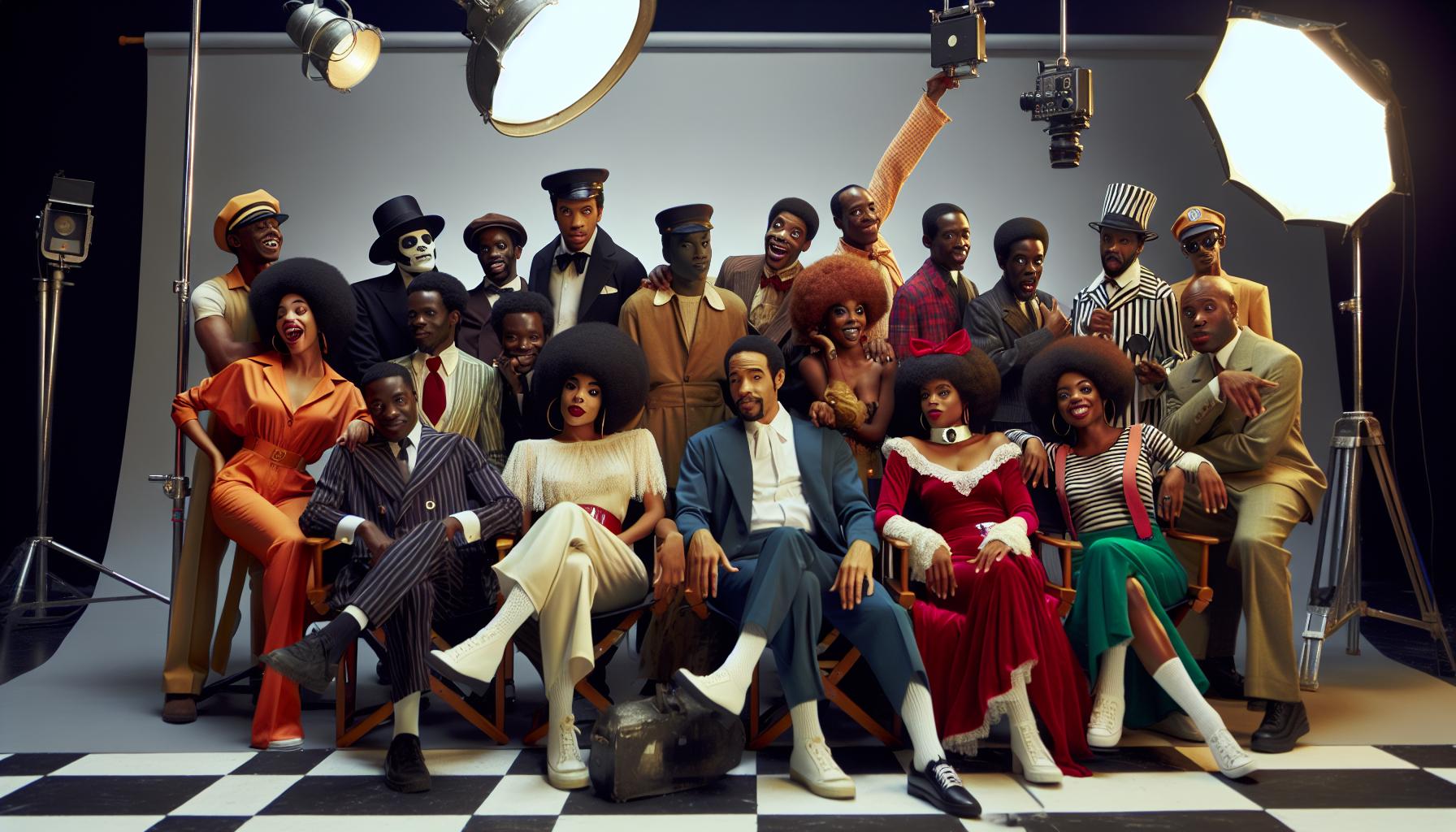Black horror-comedy films have carved out a unique niche in cinema by masterfully blending spine-chilling scares with laugh-out-loud moments. These films challenge traditional horror tropes while addressing social issues through a comedic lens. From Jordan Peele’s groundbreaking “Get Out” to the cult classic “Tales from the Hood” these movies prove that fear and laughter can coexist brilliantly.
Horror comedies featuring Black protagonists don’t just entertain – they’ve revolutionized the genre by bringing fresh perspectives to tired formulas. They tackle serious themes like racism systemic oppression and cultural identity while keeping audiences entertained with clever jokes and satirical commentary. Through the years these films have evolved from simple parodies to sophisticated social commentaries that resonate with viewers of all backgrounds.
The Rise of Black Horror Comedy Films
Black horror comedy films emerged in the 1970s with releases like “Blacula” but gained significant momentum in the 1990s through modern productions. These films combine spine-chilling scares with satirical elements to create unique cinematic experiences.
Blending Cultural Commentary with Dark Humor
Black horror comedies transform societal issues into compelling narratives through strategic use of satire. Films like “Get Out” (2017) integrate racial microaggressions into unsettling scenarios while maintaining darkly comedic undertones. “Sorry to Bother You” (2018) uses surreal horror elements to critique corporate culture through a distinctly Black lens. Recent productions like “Bad Hair” (2020) address beauty standards in the Black community through supernatural horror mixed with biting humor. Directors incorporate cultural references specific to Black experiences while making the commentary accessible to broader audiences.
Breaking Traditional Horror Movie Stereotypes
Black horror comedies challenge established genre tropes by positioning Black characters as protagonists rather than early victims. “Attack the Block” (2011) features inner-city youth as heroes fighting alien invaders. “Tales from the Hood” (1995) subverts anthology horror expectations by centering stories around urban issues. “The People Under the Stairs” (1991) turns conventional home invasion narratives into social commentary about housing discrimination. Modern entries feature complex Black characters who drive the plot through intelligence rather than stereotypical reactions to danger. These films create new archetypes that reflect authentic experiences while maintaining entertainment value.
Notable Black Horror Comedy Movies Through the Decades

Black horror comedy films evolved from obscure cult classics to mainstream successes, marking significant milestones in cinematic history. These productions showcase the genre’s ability to blend social commentary with entertainment.
Early Pioneers and Cult Classics
The 1972 film “Blacula” pioneered the Black horror comedy genre, mixing vampire mythology with blaxploitation elements. “House Party” (1990) incorporated supernatural elements with comedy, featuring Kid ‘n Play navigating haunted scenarios. Robert Townsend’s “The Meteor Man” (1993) combined superhero elements with horror comedy tropes, while “Tales from the Hood” (1995) presented anthology-style stories addressing urban issues through a horror lens. Rusty Cundieff’s directorial work in “Fear of a Black Hat” (1993) paved the way for social satire in horror settings.
Modern Box Office Successes
Jordan Peele’s “Get Out” (2017) earned $255 million worldwide, redefining Black horror comedy with its exploration of racial dynamics. “Little Monsters” (2019) starring Lupita Nyong’o generated $1.8 million in streaming revenue. “Bad Hair” (2020) secured a $7 million Hulu distribution deal, while “Vampires vs. the Bronx” (2020) achieved top 10 Netflix status in multiple countries. “The People Under the Stairs” (1991) garnered $31 million globally, demonstrating the commercial viability of Black-led horror comedies.
| Movie Title | Release Year | Box Office/Revenue |
|---|---|---|
| Get Out | 2017 | $255 million |
| Little Monsters | 2019 | $1.8 million |
| Bad Hair | 2020 | $7 million |
| The People Under the Stairs | 1991 | $31 million |
Key Elements That Define Black Horror Comedies
Black horror comedies integrate distinct elements that transform traditional horror narratives into powerful social commentaries while maintaining entertainment value. These films blend dark humor with frightening scenarios to create unique viewing experiences that resonate with diverse audiences.
Social Commentary and Satire
Black horror comedies expose systemic racism through metaphorical horror elements paired with satirical humor. Films like “Get Out” incorporate racial microaggressions into supernatural scenarios, turning everyday interactions into sources of terror. “Sorry to Bother You” uses surreal body horror to critique corporate exploitation of Black labor. “Bad Hair” addresses beauty standards through a possessed weave storyline that combines cultural commentary with supernatural horror. These films tackle discrimination, cultural appropriation, gentrification through clever narrative devices that balance social messaging with entertainment value.
Genre-Bending Storytelling Techniques
Black horror comedies subvert traditional genre expectations by merging elements from multiple film categories. Directors incorporate documentary-style footage, surreal sequences, supernatural elements into grounded narratives. “Tales from the Hood” uses anthology storytelling to connect urban horror stories with moral lessons. “Attack the Block” combines alien invasion tropes with inner-city youth perspectives. “The People Under the Stairs” transforms home invasion horror into commentary on housing inequality. These innovative narrative approaches allow filmmakers to address serious themes while maintaining engaging storylines that keep audiences entertained through unexpected plot developments.
Influential Directors and Writers
Black horror-comedy films showcase talented directors who merge social commentary with supernatural scares. These creators bring unique perspectives to traditional horror tropes through innovative storytelling techniques.
Jordan Peele’s Impact on the Genre
Jordan Peele revolutionized Black horror-comedy with his directorial debut “Get Out” in 2017. His masterful blend of social satire with genuine scares earned him an Academy Award for Best Original Screenplay, making him the first Black writer to win this category. Peele’s follow-up films “Us” (2019) created $255 million in worldwide revenue while expanding the genre’s storytelling possibilities. His production company Monkeypaw Productions champions diverse voices in horror cinema through projects like “Candyman” (2021) directed by Nia DaCosta. Peele’s success opened doors for more Black filmmakers to explore horror-comedy, establishing new industry standards for representation both on screen and behind the camera.
Other Groundbreaking Creators
Rusty Cundieff directed “Tales from the Hood” (1995), pioneering social commentary in horror anthologies. Kasi Lemmons crafted “Eve’s Bayou” (1997), mixing Southern Gothic elements with dark comedy. Wes Craven collaborated with Black writers to create “The People Under the Stairs” (1991), addressing racial inequality through horror. Director Justin Simien’s “Bad Hair” (2020) satirizes beauty standards using supernatural elements. Boot Riley transformed workplace satire into surreal horror with “Sorry to Bother You” (2018), grossing $18 million domestically. Contemporary creators like Gerard McMurray (“The First Purge”) continue expanding the genre’s boundaries through innovative storytelling approaches.
Cultural Impact and Critical Reception
Black horror comedies transform mainstream cinema’s representation of African American experiences. Critics praise these films for their sophisticated blend of social commentary with genre elements. The New York Times highlighted “Get Out” as a watershed moment, earning a 98% rating on Rotten Tomatoes alongside its groundbreaking Oscar win.
Popular culture embraces these films’ unique approach to addressing racial issues through horror comedy. Social media conversations about “Get Out” generated over 2.5 million tweets during its opening weekend. Streaming platforms report increased demand for Black horror comedies, with Netflix adding 15 new titles in this genre between 2019-2023.
Academic studies recognize these films’ contributions to cultural discourse:
- Integration of Black perspectives in horror narratives
- Subversion of traditional horror tropes
- Commentary on systemic racism through satire
- Representation of complex Black characters
Box office performance demonstrates growing audience appreciation:
| Film Title | Year | Box Office Revenue |
|---|---|---|
| Get Out | 2017 | $255 million |
| Us | 2019 | $255.2 million |
| Tales from the Hood | 1995 | $11.8 million |
| Bad Hair | 2020 | $3.4 million (streaming) |
Film festivals showcase these movies’ artistic merit. Sundance Film Festival featured eight Black horror comedies between 2017-2023. Critics celebrate how these films balance entertainment with social messaging, earning nominations at prestigious awards ceremonies including the Academy Awards, Golden Globes and BAFTAs.
Industry recognition extends beyond box office success. Film schools incorporate these movies into curriculum studies. Major studios increase funding for Black horror comedy projects, with five major production deals announced in 2023.
Looking at Future Trends in Black Horror Comedy
Streaming platforms increase production budgets for Black horror comedy content, with Netflix allocating $100 million to diverse genre projects in 2023. Major studios partner with emerging Black filmmakers, creating opportunities for fresh perspectives in horror comedy storytelling.
Technology advances shape new storytelling methods in Black horror comedy:
- Virtual reality experiences integrate social commentary with interactive scares
- Augmented reality elements enhance theatrical releases with immersive components
- AI generated content assists in creating more sophisticated practical effects
- Social media integration expands narrative possibilities across platforms
| Platform | Investment in Black Horror Comedy (2023-2024) |
|---|---|
| Netflix | $100M |
| Amazon | $75M |
| Hulu | $50M |
| HBO Max | $45M |
Independent filmmakers leverage digital distribution channels to reach global audiences, bypassing traditional gatekeepers. Horror comedy anthologies focusing on Black experiences gain traction on streaming services, with 5 new series announced for 2024.
Emerging themes in upcoming releases include:
- Tech dystopia narratives exploring digital discrimination
- Environmental horror comedies addressing environmental racism
- Workplace horror satires examining corporate diversity initiatives
- Supernatural stories incorporating African diaspora folklore
- Genre mashups combining horror comedy with science fiction
International collaborations expand the scope of Black horror comedy, with co-productions between US African American filmmakers eastern African studios creating unique cultural perspectives. Cross cultural storytelling enriches the genre through diverse viewpoints multicultural casting representation.
Conclusion
Black horror comedy has transformed from a niche genre into a powerful medium for social commentary and entertainment. Through masterful storytelling these films continue to challenge societal norms while delivering both scares and laughs to diverse audiences worldwide.
The genre’s evolution showcases its ability to tackle complex issues through creative storytelling techniques. As streaming platforms invest more resources and emerging filmmakers bring fresh perspectives Black horror comedy will likely continue to push boundaries and redefine contemporary cinema.
With increasing representation both on-screen and behind the camera the future of Black horror comedy looks promising. This dynamic genre stands as a testament to the power of combining entertainment with meaningful social commentary.

